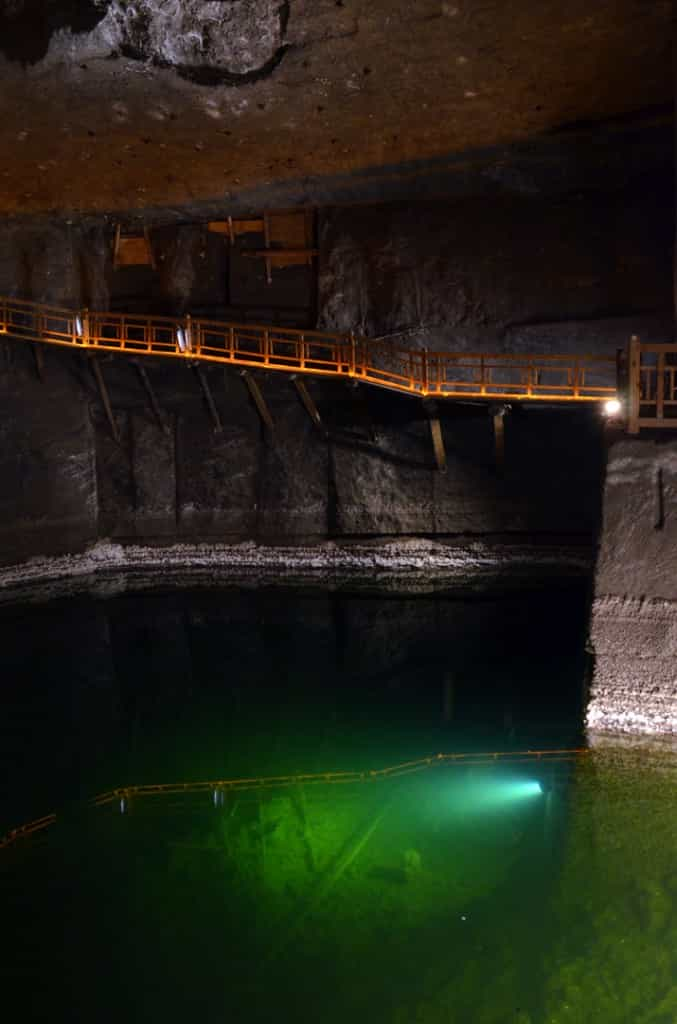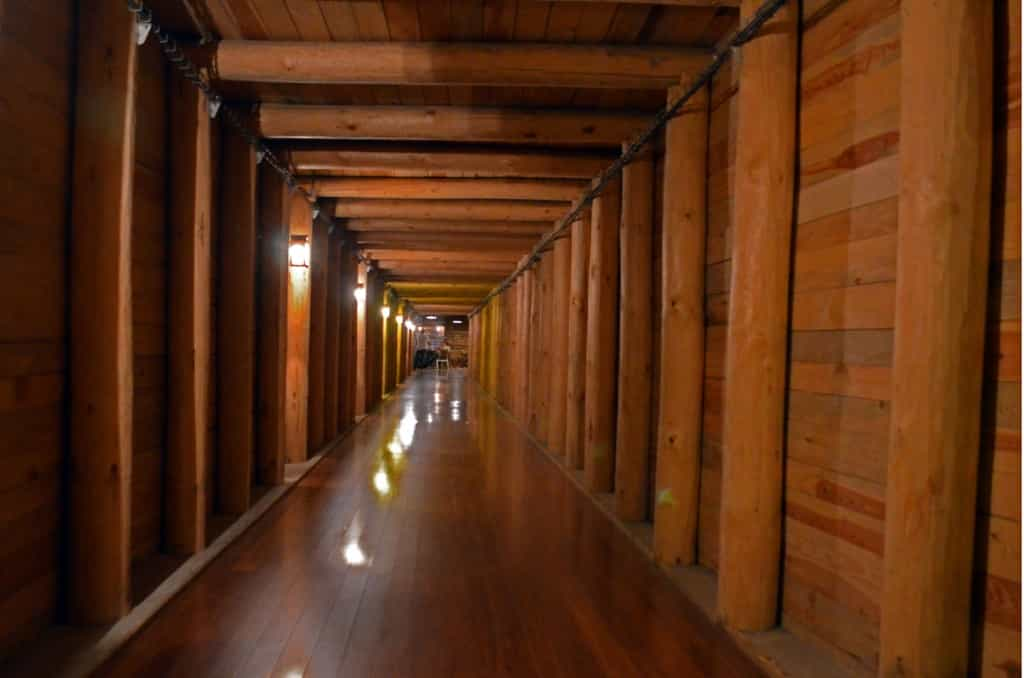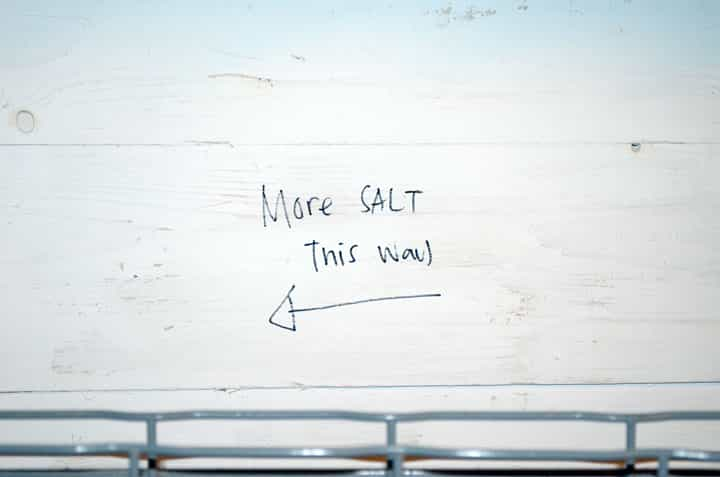From the outside, it seems rather banal. After buying a somewhat expensive ticket, you go inside in organized groups (mandatory), and make your way down a small winding staircase. It all feels very normal, until you realize you’ve been going down for quite a while. 378 steps later, you reach the first level, 64 m bellow the surface.
In case you had missed the description, it won’t take you long to figure out what they used to mine here. The guide gave us a warning that I have never received, anywhere in the world, in any kind of attraction: “Feel free to lick the walls, lick the ceiling, but please don’t lick the statues”.
Salt was mined here from the 13th century all the way to 2007 (although large scale commercial production ceased in the 1990’s). In total, the mine contains an incredible 250 km of tunnels and an estimated 2,000 rooms.
About 2% has been modified and organized for tourism and other purposes, such as a sanatorium where the air is apparently beneficial to children with asthma, among other conditions. Here you see the old stone steps used by the miners, as well as the wooden ones built for the tourists (possibly also for the miners of the later years of salt production).
A lot of people work there full-time to maintain the mine, and the quantity of wood used to build the support structures is incredible. I realize scale is hard to see on this picture, but these white things are not popsicle sticks, they are tree trunks! There must be hundreds of thousands of tree trunks in the mine. Maybe millions?
In the old days, horses powered elevation systems. Even after the operation was mechanized, horses were still used for some tasks, with the last one leaving in 2002. Apparently it is still living somewhere on a farm, at the fairly old horse age of 26.
A multimedia display illustrates in a spectacular manner how miners of the past would conduct preventive burning of accumulated methane gas. The British “canary method” was not known in these regions at the time. I probably don’t need to specify this, but the statue is made of salt.
In fact, statues all over the mine are made of salt, this one depicting the scene of a legend surrounding Princess Kinga, the patron saint of the mine (the story might be a legend, but Kinga herself was a real Hungarian Princess who became a real Catholic Saint and the Patroness of Poland and Lithuania.
But they didn’t only build statues, they built chapels in their spare time. I think this one is the deepest, at 135 m. And they didn’t only build little chapels.
They built this! Princess Kinga’s Chapel. I don’t know what records it beats, but it must beat a few. Unfortunately, you will find much better pictures on the web because I was shooting from strange angles to try and hide the large scale preventive maintenance work happening on the left side.
There is no doubt the Wieliczka Salt Mine is one of the world’s major touristic attraction. On the UNESCO’s original 1978 World Heritage Site list, it is visited by 1.2 million tourists a year, and has attracted the likes of Bill Clinton and Pope John Paul II. But it is also a very old attraction; notable tourists of the past include Chopin, Goethe and even Copernicus!
The altar, as far as I know all made from rock salt.
The former Pope visited 3 times; twice as a student and once as a Cardinal, but never as Pope.
I don’t think he ever visited.
Towards the end of the commercial exploitation, flooding became a major concern, as well as collapsing salt prices with the arrival of new efficient ways of harvesting it, as I saw in Namibia. But in the old days, the salt mines, owned by the Crown, provided a full third of the Polish Kingdom’s revenues.
At one of the deepest points of the tourist route (135 m), a flooded room has a tunnel leading to a cave. In the distant past, it was possible to visit the grotto using a row boat. However, during a visit some German soldiers managed to flip the boat and ended up not drowning, but suffocating under the upturned embarkation. Because the water is fully saturated with salt, they were unable to swim under the boat to escape. Having tried – unsuccessfully – to fully submerge myself in the Dead Sea, I can believe it. But although I wasn’t there, I would bet $1000 this was an alcohol related accident. Nowadays, a new system of a boat on a rail is being considered for approval by the Polish organization in charge of safety in mines.
As you go ever deeper, it is strange to see the tunnels go from this.
To this.
To this!
Until you get to that! In fact, there are many rooms like this one, used for Government events, conferences, weddings, etc.
One of the rooms we visited was just about to close because the workers were going to prepare it for an event. Carts and carts of flowers were being delivered in preparation for whatever was going to take place there.
On top of the 1.2 million tourists, the sanatorium and the multitude of events, the mine also has several shops, restaurants, a museum and offers many more tours, focused on the life of miners at the time or religious sites. Many employees also work to preserve the historically important sectors and backfill the rest of the mine with a sand compound of some sort to improve the geological stability of the area.
And finally I have to say; graffiti is vandalism, but some tourists have a good sense of humour!
#Poland





















love this
Phenomenal pictures and some funny anecdotes! Really enjoyable to see.
Thanks for the compliments!